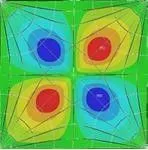The assessment of structural energy flow is an important diagnostic tool in noise and vibration control. The determination of structural intensity from measurement data of the flexural wave motion in structures allows the localization and analysis of vibrational sources and sinks. Knowledge about the vibrational sources and sinks can assist professionals to devise appropriate solutions to noise and vibration problems.
This presentation gives an overview of the methods (in tutorial-style) to estimate the structural intensity in plate-like structures from laser Doppler vibrometry measurement data. More specifically it focusses on the determination of the irrotational part of the structural intensity. The irrotational intensity indicates how the energy flows from the sources towards the structural "far field". The rotational part indicates how the energy loops, and is not related to the energy flow at large distances from the source. The extraction of the irrotational intensity has significant advantages in that it visualizes the energy flow without the masking effects of energy loops that are related to the rotational intensity. Some practical cases in the field of building acoustics applications will be shown.
Date: June 7, 2019, 3:30–5:00 p.m.
Speaker: TUM-IAS Visiting Fellow Prof. Nicolaas Bernardus Roozen (Physics and Astronomy, KU Leuven)
Location: MW3102 (Mechanical Engineering building, Boltzmannstraße 15, 85748 Garching)
More information can be found at this decription.
